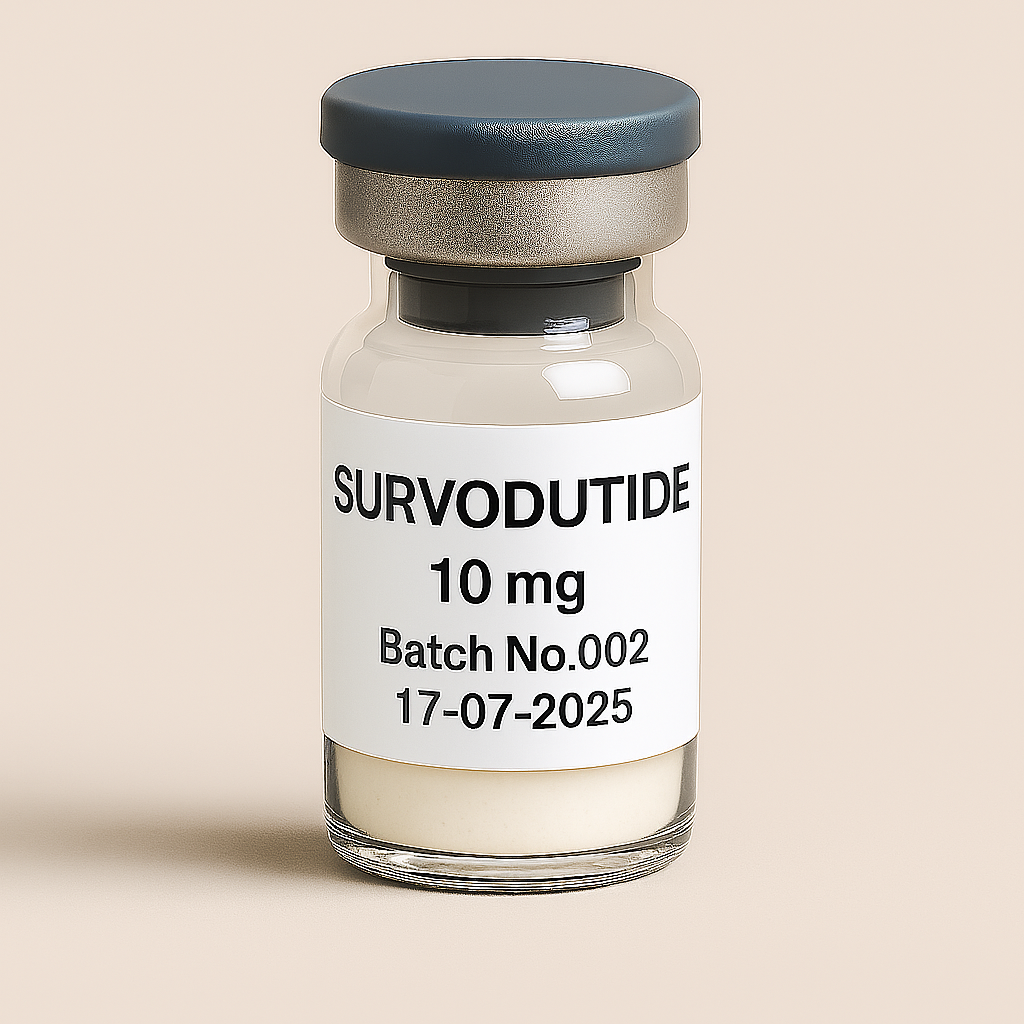
Survodutide 10mg vial
Pickup currently not available
NOT FOR HUMAN CONSUMPTION
Survodutide is a once-weekly, injectable dual agonist of the glucagon receptor (GCGR) and the GLP-1 receptor (GLP-1R) being co-developed by Zealand Pharma and Boehringer Ingelheim for obesity, metabolic dysfunction-associated steatohepatitis (MASH), and related cardiometabolic complications. By uniting appetite suppression (via GLP-1R) with a glucagon-driven rise in energy expenditure and hepatic fat mobilisation, it aims to deliver larger, metabolically healthier weight loss than GLP-1-only drugs.
| Benefit | Key take-aways | |
|---|---|---|
| 1 | Liver disease reversal | In the Phase 2 MASH study, 83 % of patients achieved complete histologic resolution and one-third showed ≥1-stage fibrosis regression after 48 weeks—rates not yet matched by GLP-1–only drugs |
| 2 | Powerful lipid lowering | Exploratory analyses reported triglyceride falls of up to 75 %, free-fatty-acid drops of 49 %, and modest LDL/VLDL reductions, pointing to a cardiometabolic benefit that goes beyond weight loss. |
| 3 | Blood-pressure reduction | Mean systolic/diastolic BP fell by roughly 10/5 mmHg alongside a 17 cm shrinkage in waist circumference—clinically relevant for hypertension and visceral-fat risk. |
| 4 | Higher energy expenditure | Pre-clinical work with BI 456906 shows a ~10 % rise in resting metabolic rate, suggesting the dual agonist can counteract the adaptive metabolic slowdown seen with calorie-restriction or GLP-1 monotherapy. |
| 5 | Lean-mass preservation | MRI sub-studies indicate that the majority of weight lost is adipose tissue, with lean-mass loss proportionally lower than the ≈25 % seen after diet or bariatric surgery. |
| 6 | Early glycaemic gains in pre-diabetes | Participants with HbA1c 5.7–6.5 % saw fasting-glucose drops of up to 13 mg/dL by week 46, before substantial weight had even been lost. |
| 7 | Cardiac function signal | In a diet-induced-obese hamster HFpEF model, survodutide improved diastolic function and lipid parameters independent of weight change, supporting the rationale for the ongoing cardiovascular-outcomes trial. |
| 8 | Durable visceral-fat shrinkage | A meta-analysis (1 029 participants) found average waist-circumference reductions of 8.4 cm, scaling with dose (>2 mg) and exposure (>16 weeks). |
| 9 | Medication de-intensification in type 2 diabetes | In Phase 2 diabetes cohorts, HbA1c fell by up to 1.6 % within 16 weeks, allowing one-third of subjects to down-titrate or stop other glucose-lowering agents. |
2. Pre-clinical insights
Rodent models fed a high-fat diet showed that survodutide increased total energy expenditure, lowered body weight and improved glycaemic control more than either semaglutide or long-acting glucagon analogues alone. Mechanistically, hepatic GCGR activation ramped up β-oxidation and thermogenesis, while GLP-1R agonism curbed intake.
3. Pharmacokinetics & dosing principle
A proprietary fatty-acid side-chain extends half-life to ≈5 days, enabling once-weekly SC administration. Phase 1 studies established linear PK, no significant accumulation, and a tolerability-guided step-up schedule now standard in late-stage trials (0.3 mg start, titrated to 3.6 mg or 6.0 mg).
4. Clinical evidence so far
| Indication | Key study (phase) | Population & dose | Duration | Top-line efficacy |
|---|---|---|---|---|
| Obesity (no diabetes) | NCT04667377 (Phase 2) | 4 weekly doses up to 4.8 mg | 46 w | −18.7 % mean weight in 4.8 mg completers; ≥15 % loss in 55 % of all-comers |
| Type 2 diabetes | Randomised Phase 2 | 0.6–3.6 mg | 16 w | HbA1c −1.6 % and weight −8.7 % at 3.6 mg |
| MASH with F2–F3 fibrosis | Phase 2 (NEJM) | 2.4–6.0 mg | 48 w | 83 % histologic MASH resolution vs 18 % placebo; ≥1-stage fibrosis improvement in 34–36 % |
Obesity trial sources AJMCPMC – Diabetes PMC – MASH New England Journal of MedicinePubMedFinancial Times
Safety profile – Across trials, gastrointestinal events dominate (nausea ≈ 66 %, vomiting ≈ 41 %, diarrhoea ≈ 49 % at therapeutic doses). Serious AEs were comparable to placebo, but discontinuation risk is ~4-fold higher than placebo—driving the lengthened titration in phase 3. PubMedPMC
5. Phase 3 programme (2025 status)
| Programme | Target cohort (N) | Primary end-point | Status / read-out |
|---|---|---|---|
| SYNCHRONIZE-1 | Obesity, no T2D (≈ 7 00) | ≥ 5 % & ≥ 10 % weight loss at wk 76 | Last patient out expected Dec 2025 |
| SYNCHRONIZE-2 | Obesity + T2D | Same | Parallel timeline |
| LIVERAGE / LIVERAGE-Cirrhosis | MASH F2–F3 / F4 | Histologic resolution ± fibrosis | Recruiting; baseline imaging & NIT poster at EASL 2025 |
| SYNCHRONIZE-CVOT | Obesity/overweight with CV risk (4 935) | 5-point MACE | Active, not recruiting; last update Jul 2025 |
Boehringer projects first filings in 2027–28 if these trials meet endpoints
References
-
Sanyal AJ et al. A Phase 2 Randomized Trial of Survodutide in Adults with MASH and Fibrosis Stages 1–3. N Engl J Med 2024.
-
Lucas KJ et al. “Survodutide Weight Loss Is Associated with Changes in Plasma Free-Fatty Acids and Triglycerides.” ADA abstract 1635-P, 2024; and Le Roux CW et al. Survodutide Improves Cardiometabolic Parameters in Adults with Obesity. Eur Heart J Suppl 2024.
-
Le Roux CW et al. Survodutide Improves Cardiometabolic Parameters in Adults with Obesity. Eur Heart J Suppl 2024; plus Hennige AM et al. “Survodutide: A Promising Agent for Obesity and Type 2 Diabetes.” Auctores Online 2025.
-
Müller TD et al. “Discovery and Pre-clinical Pharmacology of the GCGR/GLP-1R Dual Agonist BI 456906.” Molecular Metabolism 2023.
-
Le Roux CW et al. “Glucagon and GLP-1 Receptor Dual Agonist Survodutide for Obesity: Body-Composition Findings.” Lancet Diabetes Endocrinol 2024.
-
Abstract 6926. 19th Cardiometabolic Health Congress, 2024.
-
ADA 2025 abstract 1704-P. “Survodutide Improves HFpEF and Dyslipidaemia in a Hamster Model.”
-
Shi LL et al. “Effect of Survodutide on Weight, BMI and Waist Circumference: Meta-analysis of 18 Study Groups.” Diabetol Metab Syndr 2024.
-
Nuijten MAH et al. Survodutide Trial Rationale in Type 2 Diabetes (SYNCHRONIZE-2). Obesity 2025.

